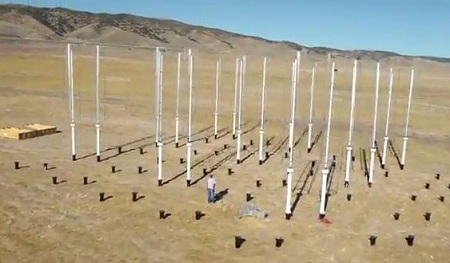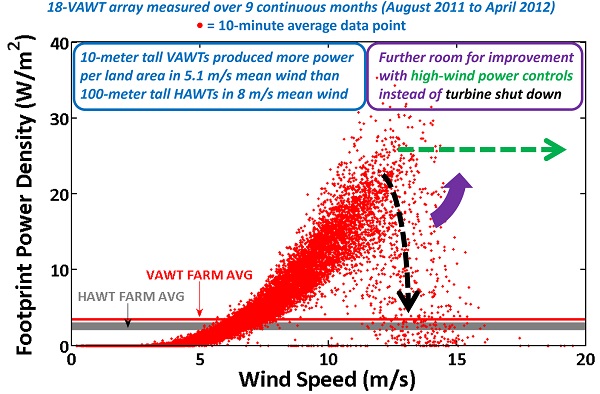The trend in turbine design has been toward taller and bigger, as the wind power industry tries to maximize generating capacity. But researchers from Caltech suggest the developers might be going about it all wrong – they say much shorter vertical-axis turbines, placed in a tight array with each turbine turning in an opposite direction to its neighbors, can be at least 10 times as efficient at capturing the wind power in a given area.
John Dabiri, a Caltech professor of aeronautics and bioengineering, and his colleagues base their theory on work done at the university’s two-acre experimental wind farm in northern Los Angeles County, and describe their findings in detail in the July issue of the Journal of Renewable and Sustainable Energy.

Dabiri began exploring the possibilities with vertical-axis wind turbines (VAWTs) after recognizing the inefficiency of the common horizontal-axis turbines (HAWTs) – not individually (they’re actually quite efficient individually), but together in their typical positioning. HAWTs need to be spaced widely to avoid clipping each other, and they also lose efficiency when they create wakes that disturb the turbines around them. In these traditional wind farms, “much of the wind energy that enters a wind farm is never tapped,” Dabiri says.

The VAWTs Dabiri and his colleagues tested – described by Caltech as looking like upright eggbeaters – were just 10 meters tall and 1.2 meters wide. That’s puny compared to the traditional industrial turbines, which have blades often more than 40 meters long and typically stand well over 100 meters tall. But Dabiri says there’s more than enough energy available in the wind at the lower heights, and by using the much less expensive VAWTs – “smaller, cheaper and less environmentally intrusive,” according to Caltech – we have a much better chance of capturing that available energy.
UPDATE (April 2013): This story was edited after its original publication in July 2011 to clarify the use of the term “efficiency.” In addition, further testing in 2012 appears to suggest Dabiri and his colleagues are on to something with this concept. They report that 18 of their eggbeaters, operating over nine continuous months to April 2012, “produced more power per land area in 5.1 m/s mean wind than 100-meter tall HAWTs in 8 m/s wind.” As the graphic below notes, the researchers believe their turbines could do even better with the addition of high-wind power controls that would allow the turbines to continue to produce power — instead of shutting down — at high wind speeds.

UPDATE 2: (February 2014): Those interested in this concept will very much want to see Professor Dabiri’s lecture last fall at the Midwest Mechanics Seminar. It runs for 40 minutes and is available here.